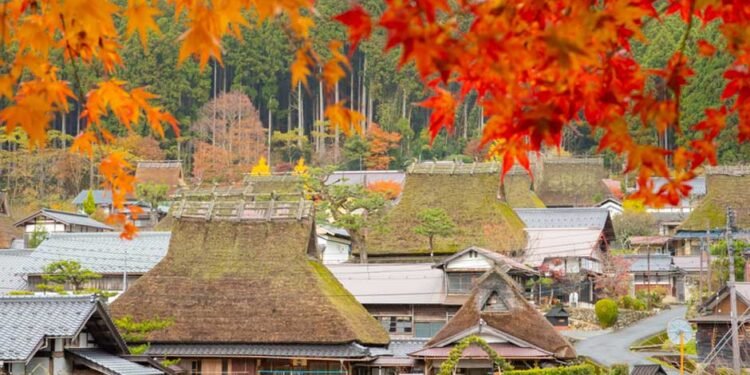In the serene Kyoto countryside, Miyama is a picturesque village that offers a glimpse into Japan’s pastoral past. With its charming thatched roofs and traditional houses, this village transports visitors to a simpler time, preserving a way of life that has remained unchanged for centuries.
The Allure of Traditional Architecture
Miyama and Kayabuki-no-Sato are renowned for their well-preserved kabuki (thatched) houses, a testament to traditional Japanese architectural techniques. These houses are characterized by their steep, reed-covered roofs, designed to withstand the heavy snowfalls typical in the region. Approximately 38 thatched homes in the area have been meticulously maintained, functioning as private residences even as they attract tourists worldwide. Walking through the village, one can appreciate the intricate craftsmanship that goes into the construction and upkeep of these historic dwellings.
A Living Museum of Rural Life
Visiting Miyama Kayabuki-no-Sato is akin to stepping into a living museum. The village is a preservation area for buildings and the lifestyle of rural Japan. Here, agriculture remains a way of life, with locals engaging in farming and other traditional activities. Seasonal changes bring different charms to the village, from vibrant green rice fields in the summer to the snowy white landscape in winter. The community actively preserves their homes, and the customs and traditions are passed down through generations.
Cultural Activities and Experiences
For those interested in experiencing the culture of rural Japan, it offers more than just visual delights. Visitors have the opportunity to engage in various cultural activities that provide deeper insights into traditional ways of life. These include workshops on thatching, where one can learn about the materials and techniques used to maintain the kabuki houses’ roofs. Other activities may involve traditional cooking classes, where guests can prepare and enjoy local dishes made with fresh, seasonal ingredients sourced directly from the village.
Nature and Scenery
The natural surroundings of Miyama are as captivating as the village itself. Located in a mountainous area, it offers numerous scenic walks and hiking trails that allow for exploration of the lush forests and clear streams that characterize the landscape. These natural elements play a crucial role in the village’s life, influencing the agricultural practices and providing a stunning backdrop to the traditional architecture.
Sustainable Tourism Efforts
The preservation of Kayabuki-no-Sato is a fine example of sustainable tourism. Efforts to maintain the village’s cultural heritage are balanced with the need to accommodate visitors in a way that does not disrupt the natural or social environment. The community’s approach includes limiting the number of visitors during peak seasons and ensuring that tourism activities are in harmony with the villagers’ daily lives. This careful management helps sustain their authenticity and charm for future generations.
Visiting and Supporting the Village
For those planning a visit, Miyama is accessible from Kyoto and offers a peaceful retreat from the hustle and bustle of city life. Tourists are encouraged to respect the tranquility and privacy of the villagers while enjoying the unique atmosphere of the village. Supporting local businesses and purchasing local products can contribute to the community’s economy and aid in the ongoing efforts to preserve this beautiful part of Japan.
Miyama and Kayabuki-no-Sato are beautiful relics of Japan’s rural heritage, offering an enchanting experience for anyone wishing to explore the country’s traditional lifestyle. Their thatched roofs not only shelter the residents but also stories and customs that have endured through the ages. For those seeking a deeper understanding of Japanese culture and history, visiting this thatched village is an essential and unforgettable journey into the past.












